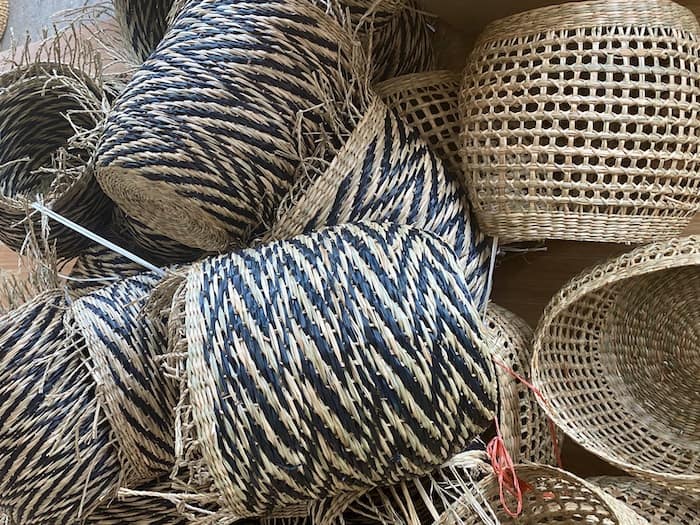For thousands of years, people worldwide have been weaving seagrass. Some experts believe using seagrass in weaving objects could go back 10,000 years.
True to its name, Seagrass is a type of grass that thrives in saltwater environments, including the tropical oceans accessible to Vietnam. In Vietnam, abundant seagrass is cultivated for the specific purpose of weaving it into various home decor items. This process involves cutting, drying, spinning, dyeing, and weaving the seagrass into baskets, lampshades, furniture, and area rugs. Beyond its versatility, seagrass boasts eco-friendly attributes, serving as a sustainable alternative to plastic materials.
Table of Contents
- Video On All Kinds of Weaving
- What is Seagrass?
- Seagrass for Weaving Home Decor Products
- Frequently Asked Questions
- Related Content
Video On All Kinds of Weaving
Here is a video to show some different kinds of weaving. Weaving baskets and other items are truly hand-made.
What is Seagrass?
Seagrass is an actual grass that grows in the sea or salt water. In many places in Vietnam, it goes inland in some marshy waterways with salt from the ocean.
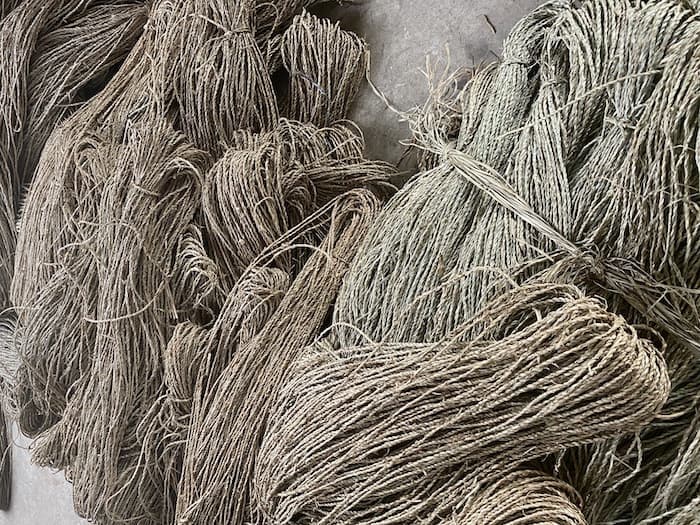
Here are a few facts about seagrass:
- Grass with a root—Seagrass is similar to the grass that may grow on your front lawn. However, seagrass has an actual root that grows into the bottom of the ocean or waterways.
- In Swallow Waters: Seagrass can be found in the ocean and shallow waterways near the shore. However, it must have salt in the water for it to grow.
- Found Worldwide – Seagrass is found worldwide, from abundant tropical waters in parts of Vietnam to areas near the North Pole.
- Long Green leaves and flowers – Seagrass has long green leaves, roots, fruits, and other seeds. Many of these long leaves will shoot up out of the water. You can tell the seagrass as it has small flowers on it.
- Can be confused with seaweed—Some people confuse seagrass with seaweed, but the two are very different in that seaweed does not hold fast with roots underground, nor does it have flowers like seagrass.
- There are many kinds of species – Seagrass has a variety of species. Vietnam alone has over 14 different species of seagrass.
- Seagrass provides food – Seagrass can provide food for other sea wildlife, such as fish and marine organisms. Thus, seagrass is often used as a measure for scientists to check how healthy the ocean system is.
- Grows Abundantly in Vietnam – Seagrass continues to grow abundantly in Vietnam and parts of North Vietnam. The seagrass there will shoot up out of the salty water beneath it so that it can be cut and dried to be used for weaving. These areas where the seagrass grows so abundantly are known as seagrass beds. Some of these seagrass beds are so large they can be seen from outer space.
- Seagrass is a fast-growing plant – Seagrass, especially in tropical areas like Vietnam, is a fast-growing plant.
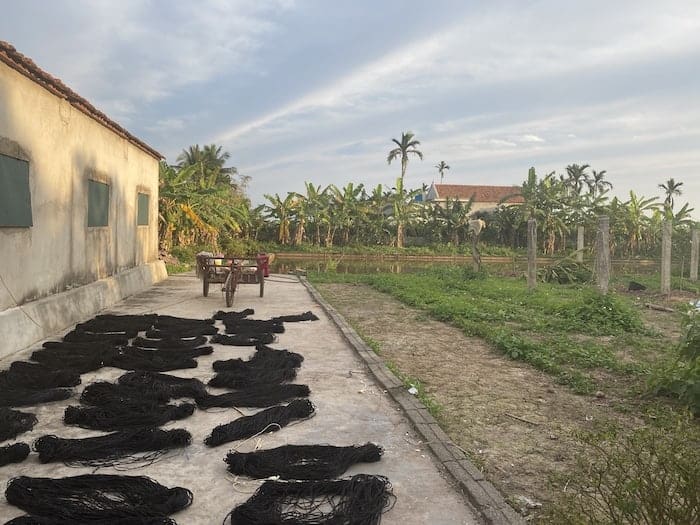
Seagrass Supports Entire Communities
Seagrass production helps to support entire communities in North Vietnam. There are many stages involved in seagrass production.
Here are some of the stages of seagrass production and how it supports the local communities:
- Farmers—Many farmers grow seagrass specifically for the weaving of handicraft products. These farmers harvest long, naturally white seagrass that is free from black spots caused by stem bores. This is important to ensure the material does not have many spots or faults.
- Drying Seagrass – Others are involved in ensuring the seagrass dries appropriately. Once cut, the grass must be dried. It cannot be used for home decor or home furniture production if it is not dried.
- Spinning and Dyeing – Many dried seagrasses are spun or twisted to give them a rope-like quality. Though they do not have to be made into ropes, many seagrass production kinds will use seagrass ropes for weaving. Seagrass can also be dyed into a variety of colors.
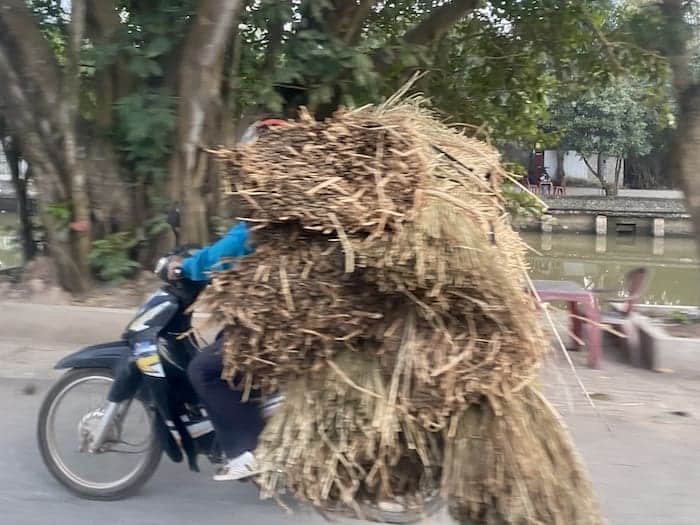
Seagrass Helps Women in Vietnam
A lot of weaving of seagrass products in Vietnam is done at home and by women. These women’s husbands are usually farmers and need this extra income to help their family’s economic situation.
The weaving of the baskets and other products allows these women to stay at home and tend to their families, small gardens, and domestic livestock while earning some much-needed extra income.
These women have their home-based businesses, as so many women worldwide have. At Mondoro, we strive to collaborate in manufacturing that specifically helps women. This is one reason we love the weaving of items like seagrass baskets, as this helps women stay home while earning an income.
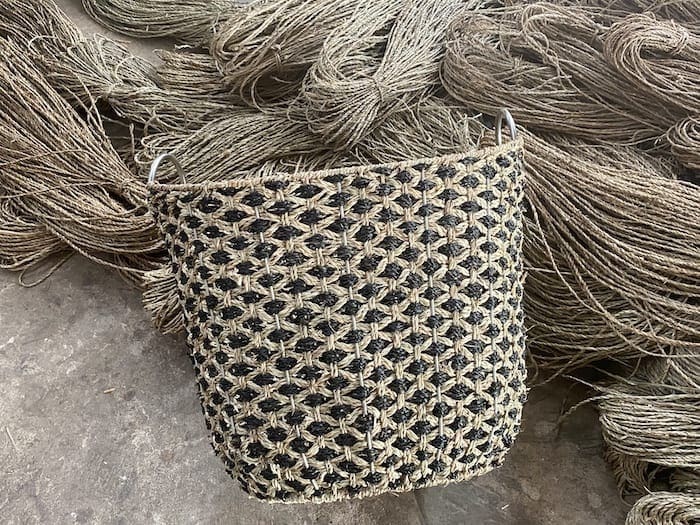
Seagrass Is An Eco-friendly Alternative to Plastic
There is no doubt that plastic is quickly killing our environment. We constantly use plastic from the plastic bottles we drink from and the plastic bags we use to do our shopping.
Materials like seagrass are an eco-friendly alternative to plastic. They are not only lightweight but also are biodegradable. Plastic will take a long time to degrade; seagrass and other natural fibers will degrade very quickly. This makes seagrass a great eco-friendly choice and alternative to plastic.
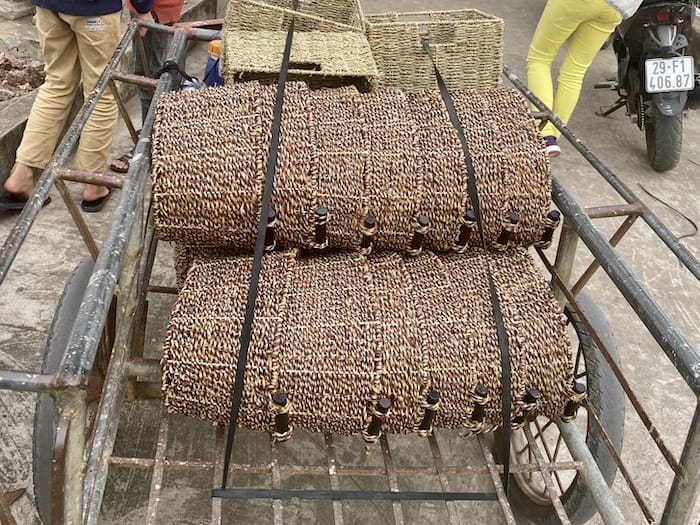
Seagrass for Weaving Home Decor Products
Once the seagrass is cut, it must be prepared to weave baskets and other products.
Here is some information about seagrass for weaving products:
- Seagrass Must Be Dried – The seagrass used for weaving baskets must be dried properly before it can be used for weaving. If it is not dried correctly, this can cause other issues in production.
- Seagrass Can Be Spun – Many seagrasses are spun or twisted into a rope and then woven.
- Seagrass Can Be Left Unspun- Seagrass can also be woven with the natural leaf.
- Seagrass Can Be Dyed – One of the great benefits of seagrass is that it can be dyed into various colors. This gives it an excellent look for many home decor products.
- Seagrass Can Be Painted – Your seagrass baskets can also be painted. Designers often paint them to add color or design.
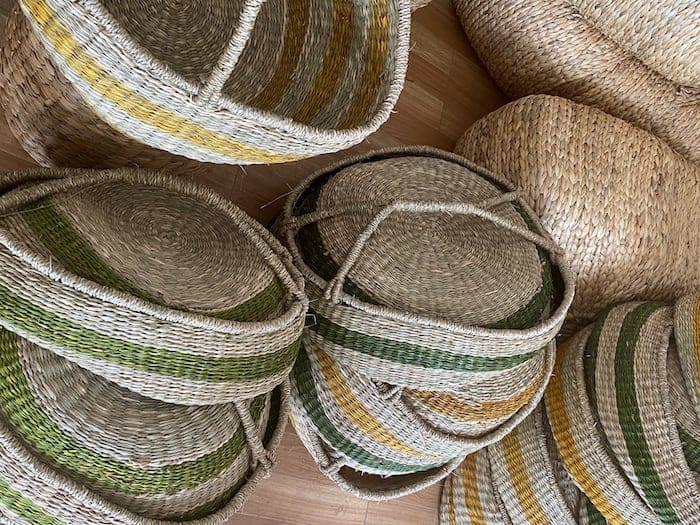
Use of Seagrass Materials for Home Decor Products
There are a lot of ways that you can use seagrass for home decor and home furniture production.
Here are some of the more common ways it can be used:
- Baskets—One of the top ways seagrass can be used in home decor is in basket production. A lot of seagrass material is used in home decor for basket production. Seagrass can be dyed in many colorways and weave up a nice-looking basket.
- Lampshades and Lighting – Seagrass can also be used for various lampshades and lighting products.
- Furniture—Seagrass can be used to weave some furniture items; it has also been used for centuries as a chair seating material.
- Mirrors and Wall Art – Seagrass can be woven on a frame, and you can also use it for wall art and mirrors. This is a great way to give your wall decor a nice, natural look.
- Area Rugs—Seagrass is an excellent material for all woven area rugs. These rugs can give the home a very natural look and feel.
As natural materials continue to dominate home decor and furniture trends, seagrass will undoubtedly continue to play a role in this trend. Not only is seagrass eco-friendly, but it is also a great alternative to plastic. Seagrass is simply a versatile material that is beautiful when woven into various products.
How to Clean A Seagrass Rug?
A seagrass rug is a great natural addition to your home.
Here are ways you can clean a seagrass rug:
Vacuum The Rug Regularly – A seagrass rug must be vacuumed regularly with a suction brush. It is good to do this a few times a week.
Scrap off Spills – If you spill something on the seagrass rug, try to scrape it off it as much as you can. Then also try to vacuum clean off the area,
Clean Up Liquid With A Paper Towel – Clean up any spilled liquid with a paper towel.
Wash the Area – You can also wash the area where the spillage is present. Some soap is a liquid dish soap as Dawn or baby shampoo in some water to clean up with a towel to wash the area mix. Try to get the rug as dry as possible. You can try to dry the air with a blow dryer to completely dry the area.
To find out more about how to clean a seagrass rug, here is some very good information on how to clean a seagrass rug.
What is the difference between water hyacinth and seagrass materials?
Water hyacinth is a natural material that grows in the waterways. It usually floats on top of the water and needs freshwater or river water. You can read more about water hyacinth by reading our blog About Weaving Water Hyacinth Baskets Into Home Décor Products by clicking here.
Seagrass is not the same kind of material as water hyacinth, though, at times, they can look similar. Seagrass is a grass that must have saltwater for it to grow.
Frequently Asked Questions
What is seagrass?
Seagrass is a type of grass that grows in the sea or saltwater areas. It is found in coastal regions, including tropical oceans, and Vietnam has access to abundant seagrass due to its coastal location.
How is seagrass used in Vietnam for home decor products?
In Vietnam, seagrass is cut, dried, spun, dyed, and woven into various home decor items such as baskets, lampshades, furniture, and area rugs.
Is the seagrass used for weaving in Vietnam farmed or harvested from the wild?
Much of the seagrass used for weaving in Vietnam is farmed specifically for this purpose. It is cultivated, cut, and processed to meet the requirements of the weaving industry.
What are the benefits of using seagrass for weaving?
Seagrass has several benefits for weaving, including being a sustainable and renewable material. It offers strength, durability, and a natural aesthetic appeal to home decor products.
Is seagrass weaving eco-friendly?
Yes, seagrass weaving is considered eco-friendly. Seagrass is a natural, biodegradable material that grows abundantly, making it a sustainable alternative to materials like plastic.
What makes seagrass a sustainable material?
Seagrass is sustainable because it is a renewable resource that grows naturally in the ocean. It can be harvested without causing significant harm to the seagrass beds or marine ecosystems.
Does seagrass weaving support local communities in Vietnam?
Yes, seagrass weaving provides livelihood opportunities for local communities in Vietnam. It creates jobs and income for artisans involved in the production of seagrass-based home decor products.
Can seagrass be dyed in different colors?
Yes, seagrass can be dyed in various colors using natural or synthetic dyes. This allows for customization and the creation of vibrant and attractive designs.
Are seagrass products long-lasting?
Seagrass products can be long-lasting with proper care and maintenance. Regular cleaning, avoiding excessive moisture, and protecting them from direct sunlight can help prolong their lifespan.
We would love to hear from you if you want to develop and manufacture seagrass products for your home decor collection.
Find out more about how Mondoro can help you create, develop, and manufacture excellent home decor and home furniture products – including seagrass home decor products. Don’t hesitate to contact me, Anita. Check out my email by clicking here, or join our community and join our newsletter by clicking here.
Mondoro gives out a FREE Lookbook to anyone interested. You can receive a copy of our latest Lookbook by clicking here.
Listen to our Podcast called Global Trade Gal. You can find it on all major podcast platforms. Try out listening to one of our podcasts by clicking here.
Subscribe to our Mondoro Company Limited YouTube Channel filled with great videos and information by clicking here.
Related Content
What Is Stronger Rattan Or Bamboo?
Bamboo is more robust than rattan. Some bamboo is known even to have a higher tensile strength than steel; this is why bamboo is used as scaffolding in construction in many parts of Asia. Rattan is a vine that grows in the jungles; when rattan is manufactured into furniture, it can be solid.
You can learn more by reading our blog, What Is Stronger Rattan Or Bamboo? by clicking here.
How Do You Make A Bamboo Lamp Shade? All About Bamboo Lampshades
To manufacture or make bamboo lampshades, you need to 1) properly prepare the bamboo materials, 2) build a metal frame, 3) wrap the metal frame, 4) secure the bamboo onto the metal frame, 5) spray color on top of the bamboo shade if you desire the lampshade to be a color other than natural and 6) spray a top coat on the entire shade to protect the bamboo shade’s finish.
Our blog is about How Do You Make A Bamboo Lamp Shade? All About Bamboo Lampshades by clicking here.
Rattan Vs. Bamboo – The Differences Between The Materials Explained
Rattan and bamboo are not the same material, as they have different characteristics and uses. For example, bamboo is hollow and grows straight as a tree would. Rattan is a solid material easily bent and grows in rainforests as a vine.
You can learn more by reading our blog, Rattan Vs. Bamboo – The Differences Between the Materials Explained, by clicking here.

